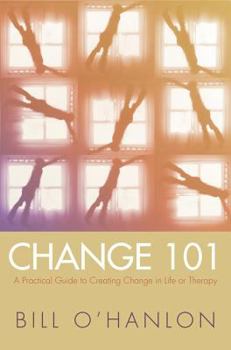Change 101: A Practical Guide to Creating Change in Life or Therapy
Select Format
Select Condition 
Book Overview
Drawing on thirty years of clinical experience, Bill O'Hanlon--one of psychotherapy's most innovative practitioners and teachers--examines this simple yet often elusive aspect of successful therapy: change. With his characteristic wit and style, O'Hanlon presents the key concepts and most powerful methods for achieving personal transformation. Readers are provided with the perspective and inspiration necessary to embrace the risk and reward of change.
Format:Hardcover
Language:English
ISBN:0393704963
ISBN13:9780393704969
Release Date:September 2006
Publisher:W. W. Norton & Company
Length:184 Pages
Weight:0.82 lbs.
Dimensions:0.8" x 5.9" x 8.4"
Customer Reviews
3 ratings
A GREAT BOOK!!
Published by Thriftbooks.com User , 14 years ago
I BOUGHT THIS BOOK FOR AN ONLINE COURSE, BUT READ THE ENTIRE BOOK IN ONE SITTING, EVEN THOUGHT IT WAS ASSIGNED OVER 3 WEEKS!
A survey recommended for both psychology collections and general-interest libraries.
Published by Thriftbooks.com User , 18 years ago
A very strongly recommended addition to the reading list of anyone who has or is contemplating any form of therapy to improve their lives or help them deal with the their problems, CHANGE 101: A PRACTICAL GUIDE TO CREATING CHANGE IN LIFE OR THERAPY tells of the one thing all therapies have in common: they all work with clients to facilitate change. That said, it's surprising that few books on therapy identify this common denominator to treatment - or survey the basic idea of what constitutes helpful change. Bill O'Hanlon provides keys to achieving personal transformation, offering specific methods to encourage change. His background as a licensed marriage and family therapist lends to reality-based discussions in a survey recommended for both psychology collections and general-interest libraries.
Delightful
Published by Thriftbooks.com User , 18 years ago
INTRODUCTION ----------------------- This is a book about overcoming resistance. It is equally applicable to being a self-help book or a book for therapists. O'Hanlon is heavily influenced by the psychiatrist Milton Erickson It is beautifully written and glides under the eye. The quotes that begin each chapter are the best that I have seen. O'Hanlon has written several books about how to change, such as Do One Thing Differently and Solution Focused Therapy. He himself says that this is the best book of his to buy about change because it incorporates things he learnt earlier and put in earlier books. He appears to have backed away from being so solution-focused because doing so is too invalidating. SUMMARY ---------------- INTRODUCTION Erikson wrote that there were "seething forces of change" within people. 1. NEVER TRY TO TEACH A PIG TO SING: FINDING THE MOTIVATION AND ENERGY TO CHANGE The anatomy of change * Negative past motivation o Diagnosis: mostly talk about past pain or dislikes (similar pattern for others) o Person might be more motivated by their wounds than by their bliss, such as being told not good enough by school guidance counsellor o Rx: "How does that hurt motivate you re the problem you brought in?" o Rx: Find out how they changed and how they stayed stuck o Rx: Link Rx with avoiding the problems again. Can always link all the special senses, thoughts, emotions, behaviours and environments of problems * Negative present motivation o When people are first admitted, they might be most motivated to change o Alcoholic hitting bottom o Rx: Find out what they don't like about the current situation and link this to the behaviour change * Negative future motivation o Rx: "Imagine, it is five years from now and you have/are still... How does that feel." / "You're 90 years old..." o Rx: What potential futures do you want to avoid? * Positive past motivation o Rx: Find what worked in the past o Rx: Find positive memories from the past o Rx: Find what changes they made because of what they brought from the past * Positive present motivation o Rx: Get more of the same o Rx: "We don't want to throw out the baby with the bathwater, so can you tell me about some parts of your life that are going well?" o Rx: Use the current positive coping mechanisms o Erickson prompted his son to think of dust on the basement floor as opposing armies * Positive future motivation o The optimists did not survive prisoner of war camps because they thought they would be freed by a particular date. o What futures would one really like to have happen, then work backwards, then find out what the person would do now o Can be linked with negative current motivation Sometimes, the person pushing for change is not the one in the office, so you need to engage the patient with the person with the motivation. For example, writing to tell the court that the offender recons they do not have any problems. You can create motivation by letting peopl





